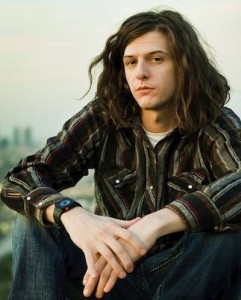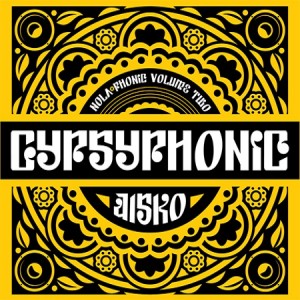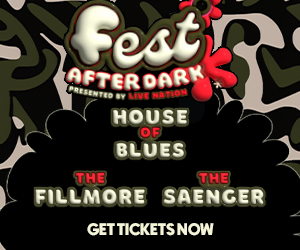“It sticks to a world bounce format.”
Quickie Mart [Martin Arceneaux] is talking about Gypsyphonic Disko‘s new release, NOLAphonic, Volume Two, which is out now (hear individual tracks here). It’s his project with Galactic’s Ben Ellman, merging bounce primarily with klezmer and Eastern European music. They released volume one in 2010, followed that Christmas by a gypsyphonic version of “The Little Drummer Boy”, adding Katey Red to Neil Diamond’s track. Last football season, Gypsyphonic Disko cut “Crunk-O-Phonic”, which set the Ying Yang Twins’ vocals on “Halftime (Stand Up and Get Crunk)” against a string-band backing, complete with an accordion solo.
Quickie Mart made his name as part of Media Darling Records’ indie hip-hop collective. 2004’s The Humid Sounds of Media Darling Records shows more enthusiasm than chops, but by the summer of 2005, their music was improving, as was the collective’s place in the city’s music community. After Hurricane Katrina, Quickie Mart settled in Los Angeles, where his career flourished. Three days before our interview, though, he moved home. His stuff had yet to make it back to town, but he had an apartment Uptown.
What brought you back to New Orleans?
Being in L.A. for six years and really missing home. I grew up in Shreveport and Baton Rouge and lived here for seven or eight years here before the storm. [After Katrina] I was in limbo, touring. I went out to L.A. a few times and liked it and had some connections.
I don’t have to be in L.A. anymore; I just need to be near the Internet and an airport and I’ll be alright, so I came home.
What did you get out of being in L.A.?
A lot of things. Freddie Gibbs, who is a friend of mine, got signed to Interscope and he got dropped; him and I were helping each other do music. Freddie signed to CTE, which is Young Jeezy’s label, so he’s all over MTV now and his career is blowing up. I remixed a Slightly Stoopid song, I’ve worked with the Cool Kids on the road, with Common. I’ve been touring constantly since I got out there. It really opened it up for me as not just a local artist but a national act.
For me, L.A. has been like paying dues, learning how the industry works at a core level. I founded a label and got a distribution deal through the largest digital distributor for electronic music, INgrooves. I’m starting to put out other people’s music in addition to my own. I’m focusing on doing digital, and then we’ll start pressing vinyl within the next year. CDs will probably be for promo only.
Can you make money that way?
Yeah, the vinyl will sell as novelty. On Soundscan last year, vinyl sales went up 36 percent and CD sales dropped six or seven percent. I think that people who buy records actually listen to it; it’s not like background iTunes. Even when we were doing Media Darling stuff, we sold out of vinyl faster than CDs, and I’m a vinyl head still, so I want to do it for me too, for fun.
Does digital pay off for you?
Yeah, I get paid quarterly. I’m putting out artists in L.A. and New York, and I’ve got some guys in Vegas I’m trying to get on the roster. No genre-specific anything.
Sorting out genres is a challenge these days. Hip-hop and electronic dance music (EDM) are both products of DJ culture, and the two seem to be crossing.
You’re right. Popularized hip-hop now on top 40 is more like house and trance music, the late ’90s Euro sound. Eventually all the dubstep and all the bass music will be called hip-hop. Hip-hop has become so sub-genred, and so has EDM.
You first made your name as part of the Media Darling group. In retrospect, it seems like y’all were ahead of your time.
I think so. We really had a great thing going on down here, and we were such a team. The storm broke everyone apart.
Would you have gotten where you are without Media Darling?
Definitely not. Media Darling taught me so much. We learned how to book tours, we learned about PR. We learned how to build a scene up, which was really awesome because it worked. I made life-long friends through that experience, and everyone’s doing their own thing right now. Know One [Roan Smith] is still doing music, and Bionik [Brown] died in Denver a couple years ago. It was a collaborative of a bunch of artists who put their resources together and made this thing pop off.
Have you listened to any of those tracks over the years?
Honestly, no. I don’t wanna listen. We put the Know One’s Home record out a little after the hurricane; I still listen to that record. That record is special to me because we recorded it in my friend’s kitchen, and then we mixed it in Roan’s back room. It was so guerilla style post-K that that record has deep meaning to me.
What other indie rappers were around before Katrina? Truth Universal?
We had Truth Univeral, Lyrikill, Impulss. It was slim, man. Jimi Clever. For a while we were doing the attic thing above Lucy’s. Every week we would have some different local thing. Even if it was someone we didn’t know, we would put them on. I think that helped a lot with the early Media Darling stuff, throwing those shows and getting everyone that did hip-hop to come and do something.
Tell me about Bionik Brown.
It’s a complete travesty. His father had a heart attack two weeks after the storm, then he went to Denver and was killed by a drunk driver on Colfax Avenue. When I played in Denver last, I went to the memorial sign, and there’s still shrapnel in the ground and stuff. Bionik [Nathan Woods] was a very spiritual person, straight-edge, very rarely cussed unless he was in an intense battle and it slipped. He never drank. He never smoked a cigarette in his life. He was such a righteous person that it’s strange that something so tragic would happen like that.
We had a group, Lucky Stiffs [Quickie Mart, Know One, Bionik Brown]. Right before the first time Galactic took us on the road, Roan got hit by a drunk driver and almost died. They said if he was wearing a seat belt, he would have been killed. He got shot 80 feet out of the car, landed on his face, shattered his femur. He has half of a metal femur now. That was a drunk driver, and the same thing happened to Nate—seven in the morning, going to work. Our last show together was Jazz Fest in ’08 on the Congo Square stage. That was a blessing to me; it’s the best way to say goodbye. Too soon, man.
In Media Darling days, y’all—Bionik particularly—defined yourself in opposition to thug culture, nothing like No Limit. These days, it seems like there’s not the same sense of opposition.
The underground hip-hop scene is nil. You go to a show anywhere around the country and it’s 80 dudes and some of their girlfriends. A lot of the hip-hop mindset—which I am guilty of having as a kid—is if it’s not the four elements of hip-hop [DJ, emcee, breakdance, graffiti], it’s not music. You stay locked into that mindset of boom-bap hip-hop and you block everything else out, and I think a lot of people stayed in that and didn’t let a lot of different sounds in. Since I moved to L.A., Gotham Green is the only guy I track with. This project is my ode to the four elements of hip-hop.
It seems like hip-hop has some of the same issues that metal and hard rock have. The male fans are so into the elements that make it pure that they don’t notice that those elements alienate women. And if there are no female fans, it can only get so big.
Hip-hop has an identity crisis. What is hip-hop now? It’s so over-saturated with different sounds. I consider hip-hop being boom-bap, sample-heavy, drum stuff. Not 808s and glamorous, trance-sounding synths. It’s lost its identity as a whole.
When you mention 808s, I think of “Planet Rock” [by Afrika Bambaataa and the Soul Sonic Force], which is classic.
I’m not talking about that 808 sound but the trance-y, popular sound. The 808 sound from back in the day on all the old LL Cool J records—that’s hip-hop, but the new 808 sound is tacky to me. I like some pop music, I do, but the overuse of the 808—the 808 has lost its identity too. [laughs] I’m guilty of using the 808 on a lot of stuff, but its so overused. That’s a nice vintage piece of gear, though.
Are you a gear collector?
A little bit, yeah. Now I’m so virtual with production—Ableton and Logic—and mix in ProTools. Unless I’m tracking something live with vocals, its all in the computer now.
Part of me sticking mostly to hardware for a long time was the hip-hop in me: You make your beats on an MPC or SP-1200, and that’s what you do because that’s how hip-hop is made. I stopped subscribing to that whole mindset a while ago.
How did Gypsyphonic Disko come about?
Ben [Ellman] called me one day and he was like, “I have this crazy idea, and I want you to help me out.” It was his birthchild, and I helped him conceive it. We met through DJ stuff. I knew the name Galactic, but I didn’t know who Ben was. We were practicing at a rehearsal place, and Ben was banging around on an MPC. We started talking about the MPC and he was talking about who he toured with. “My name’s Ben; I’m in Galactic,” and I was like, “My sister is fans of you guys.” Then we started picking each other’s brains—I’d pick his brain about industry, and he’d pick my brain about beats and ProTools.
What’s the challenge in Gypsyphonic Disko?
Other than Curb your Enthusiasm, my Jewish friends, the Klezmer All-Stars and Balkan Beat Box, I was relatively unfamiliar with Eastern European music and klezmer. For me it was a completely new world. I grew up here around bounce and ratchet and stuff, so I was familiar with that already.
My most difficult thing was researching and finding klezmer stuff that we could phrase with bounce. A lot of it isn’t in time with it, and you have to chop it up.
A lot of it was learning how to make bounce right. Rusty Lazer and Blaza helped us out with all that. I had the “Triggaman” loop already cut out, but learning the standard formula of how it really goes—I think that’s really elevated our second volume. It’s more bounce. It’s not all klezmer. There’s some New Orleans flavor in there. The first volume was experimental for us. We know now what sound we’re going for, and all the bounce people are backing it—Freedia and Sissy Nobby and even Mystikal.
Making proper bounce—what does that mean?
The “Triggaman” beat has to be in there somewhere; soul clap isn’t a necessity; chants obviously. Now with how it’s evolved into sissy bounce, rapid replay on the samples, almost glitchy.
After the first volume, we got a lot of different work from bounce artists. Ricky B. asked me to do a remix for him. I just did a remix for J-Boogie and Lateef the Truthspeaker.
When you were doing Media Darling, was their any interaction between y’all and the bounce community?
Completely separate worlds. There was no hipster element to bounce. It was strictly hood-type music. At bounce shows, you would be the only white people there. Now, when Freedia plays L.A., its all hipsters.
Tell me about yacht bounce.
Yacht bounce is strictly a fun thing. “Triggaman” beat over soft rock. You’ve gotta know Tony Skratchere [Ben Hebert] to know yacht bounce. He comes up with crazy, amazing ideas. He got all of us all over the country doing stuff. He told me about the idea last SXSW and had me laughing my ass off—”Sailing” and Doobie Brothers bounce remixes. Him and I and DJ Digital and a few other New Orleans guys put a bunch up and it went a little bit viral.






